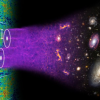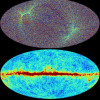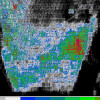Astrophysics & Cosmology
Research in astrophysics and cosmology tries to answer questions such as how did space, time, matter and energy take the form that we see today, and, can we work backwards to unravel the history of the universe. Answers are sought using NERSC for both simulation and experimental analysis of some of the most cataclysmic and some of the most subtle features of the universe. Numerical simulation is currently the dominant tool in theoretical astrophysics and cosmology and recent studies carried out at NERSC may place us on the verge of breakthrough.
The articles below describe some of the exciting research being carried out at NERSC in this field.
Cosmological Simulations for Sky Surveys
Modern cosmology is one of the most exciting areas in all of physical science. Progress over the last two decades has resulted in cementing a ‘Consensus Cosmology’ that, defined by only half a dozen parameters, is in excellent agreement with a host of cross-validated observations. Although the fact that a simple model can be so successful is already remarkable, three of its key ingredients – dark energy, dark matter, and inflation – point to future breakthrough discoveries in fundamental physics, as all require ingredients beyond the Standard Model of particle physics. Read More »
Cosmic Microwave Background
Astronomers hope to make tremendous strides toward illuminating the nature and origins of dark matter and energy by analyzing data from the Planck spacecraft. NERSC will continue its long tradition of supporting these studies via Cosmic Microwave Background simulation and data analysis. Read More »
Deep Sky Astronomical Image Database
Deep Sky is an all-sky digital image database that consists of point-and-stare observations from the Palomar-QUEST Consortium and the SN Factory + Near Earth Asteroid Team. Read More »
Type Ia Supernovae
The question of how a carbon-oxygen white dwarf accreting mass in a binary system reaches critical mass and explodes has been a robust problem in astrophysics for over 50 years and has been studied with numerical simulation for almost as long. Read More »












